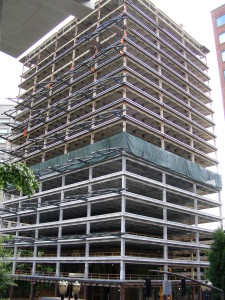The 18-story Edith Green-Wendell Wyatt Federal Building in Portland, OR, is in the midst of a massive modernization designed to make it a high-performance green building. Constructed in 1974, many of the Green-Wyatt building systems were at the end of their useful life and needed to be replaced.
The $139 million modernization project, part of the 2009 American Recovery and Reinvestment Act, will make necessary upgrades to the aging building infrastructure while achieving a 50% reduction in energy use from the existing building.
The new incorporates several efficient, sustainable, and innovative technologies that are expected to achieve a LEED Platinum rating. The 439,000-sq-ft high-rise is operated by the U.S. General Services Administration (GSA) and houses offices of the FBI, the DEA and the IRS, among others.

Interface Engineering, headquartered in Portland — known for its ecological sensitivity, technical expertise, and cost-efficient design, is the project’s plumbing engineer. According to the firm’s Portland-based senior plumbing designer, Dennis Kangas, CPD, the original systems were old and inefficient, and the plumbing, HVAC and rain harvesting pipe systems were essential to increased efficiency.
McKinstry, a full-service design-build and operation and management firm, is the project’s mechanical and plumbing contractor, and project manager Eric Peterson explained that improving the building’s efficiency while keeping an eye on costs was a top priority
At the start of the project, Ridgeline Mechanical Sales presented Aquatherm PP-R pipe to Interface. Because the project’s goal was a LEED Platinum rating, Aquatherm was chosen to fulfill the structure’s plumbing requirements. Interface principal, Jon Gray, was quite familiar with Aquatherm’s highly engineered plastic pipe systems, which have been used globally for nearly 40 years in a huge range of applications. “I’ve been sold on the product for many years and had been waiting for the market to ripen, and it seemed like the Edith Green building was a perfect fit for the project,

